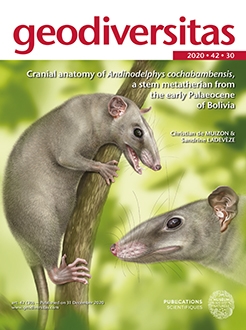Andinodelphys cochabambensis Marshall & Muizon, 1988 is one of the best preserved metatherian species from the early Palaeocene fauna of Tiupampa (Bolivia). It is represented by five almost complete skulls, three of them being securely associated to sub-complete to partial skeleton. Four skulls could be extracted from a block including several intermingled skeletons. The present paper provides a thorough description of the dental, cranial, and dentary anatomy of A. cochabambensis. The cranial anatomy of A. cochabambensis is similar to that of Pucadelphys andinus. The skull of Andinodelphys however differs from that of Pucadelphys in its larger size and proportionally longer rostrum. Other differences include the presence, in Andinodelphys, of large anteriorly protruding I1s, small palatal vacuities, a transverse canal, and a small hypotympanic sinus. Andinodelphys has the same dental formula as Pucadelphys (I 5/4, C 1/1, P 3/3, M4/4), the plesiomorphic condition for metatherians. Furthermore, both genera share the lack a tympanic process of the alisphenoid, a deep groove for the internal carotid artery at the anterior apex of the promontorium, a small prootic canal perforating the lateral edge of the petrosal and opening laterally in the deep sulcus for the prootic sinus, and a vestigial anterior lamina of the petrosal. Dentally Andinodelphys closely resembles Pucadelphys, the two genera differing in the larger size of the former and in the inconstant presence in the former of a twinned stylar cusp C. Although 25% smaller, the cheek teeth of Andinodelphys closely resemble those of Itaboraidelphys camposi from the early Eocene of Itaboraí (Brazil). As far as dental morphology is concerned, both genera are likely to have diverged from a direct common ancestor, probably Andinodelphys-like, with Itaboraidelphys displaying more derived dental structures. Two isolated petrosal from Itaboraí (Type 2 petrosals) are morphologically close to those of Andinodelphys but distinctly larger. In this paper, a previous interpretation including the teeth of Itaboraidelphys and these petrosals in the same taxon is followed. A phylogenetic analysis retrieved Itaboraidelphys as a sister taxon of the clade Pucadelphys + Andinodelphys, thus lending support to inclusion of the former in the Pucadelphyidae. Three sets of parsimony analyses were performed. A first set of analyses (with all characters) retrieved a strict consensus tree with a clade as follows: (pucadelphyids, (deltatheroidans (stagodontids, Gurlin Tsav skull-GTS), sparassodonts)). An implied weighting analysis with the same data matrix placed the stagodontids in an early diverging position but retained a clade (pucadelphyids, (deltatheroidans, (GTS, sparassodonts))), the deltatheroidans, being therefore inserted in the pucadelphydans. This result implies an independent arrival of pucadelphyids and sparassodonts to South America, which consequently must have been present in North America in the Late Cretaceous. Possible North American sparassodonts could be the poorly known genera Atokatheridium and Olklatheridium (currently referred to deltatheroidans) and the pucadelphyids may have been present in the Late Cretaceous of North America with the genus Aenigmadelphys. However, this hypothesis is less parsimonious (with regard to palaeobiogeography) than a single southward migration of an ancestral Pucadelphyda (Pucadelphyidae + Sparassodonta). Because the result of this first set of analyses may have been induced by heavily homoplastic dental characters related to hypercarnivory, a second set of analyses was performed excluding all the dental characters. The strict consensus is poorly resolved but retains monophyletic Marsupialia and Sparassodonta. An implied weighting analysis retrieved a monophyletic Pucadelphyda but split the deltatheroidans, the polyphyly of which is regarded as a possible artefact related to the lack of dental characters. The GTS is sister taxon to Pucadelphyda. Because the polyphyly of deltatheroidans contradicts all previous hypotheses, a third set of analyses has been performed excluding only those molar characters that supported the close relationships of the hypercarnivorous clades (deltatheroids, stagodontids, and sparassodonts). The strict consensus tree retrieved monophyletic deltatheroidans, Marsupialia and sparassodonts. An implied weighting analysis resulted in deltatheroidans forming a paraphyletic stem assemblage of Metatheria and monophyletic Pucadelphyda. The GTS was no longer related to sparassodonts but was the sister taxon of a clade including the North American taxa of the data matrix, Asiatherium, and Marsupialia. This topology, which is favoured here, supports (as well as that of the second set of analyses) a single pucadelphydan southward migration, probably in the Late Cretaceous, with a Tiupampian radiation of South American carnivorous metatherians.
How to translate text using browser tools
31 December 2020
Cranial anatomy of Andinodelphys cochabambensis, a stem metatherian from the early Palaeocene of Bolivia
Christian de Muizon,
Sandrine Ladevèze
ACCESS THE FULL ARTICLE
It is not available for individual sale.
This article is only available to subscribers.
It is not available for individual sale.
It is not available for individual sale.

Geodiversitas
Vol. 42 • No. 30
December 2020
Vol. 42 • No. 30
December 2020
Bolivia
cranial anatomy
early Palaeocene
Mammalia
Metatheria
phylogeny
Pucadelphyidae




